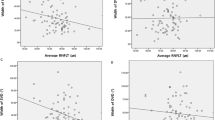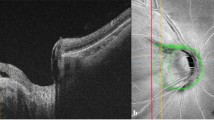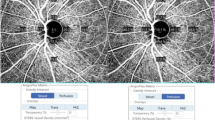Abstract
Background
To study the role of choroidal and retinal vessels in the pathology of secondary angle-closure glaucoma.
Methods
DBA/2NNia and non-glaucomatous C57BL/6J mice over the age range 2–20 months were investigated. Corrosion cast preparations of the vasculature were studied using scanning electron microscopy. Whole mounts of the retina and choroid were stained enzyme-histochemically for NADPH diaphorase as an indicator for nitric oxide synthase activity. Semi- and ultra-thin sections of the posterior eye segment were performed and evaluated.
Results
DBA/2NNia mice showed loss of choroidal pigmentation and a decrease in choriocapillary density already at 4 months of age. In animals 9 months and older, a decrease of choroidal NADPH-diaphorase positive nerve fibers was evident. The retinal vasculature showed only mild changes in NADPH-diaphorase staining, even in the oldest animals. The ultrastructural appearance of the retinal vessels was similar in both mouse strains and for all ages investigated.
Conclusions
Choroidal changes in the DBA/2NNia mouse are similar to that seen in other glaucoma models. The lack of retinal vasculature changes in adult and senescent DBA/2NNia mice suggests a normal blood supply of the retina during the progress of secondary angle-closure glaucoma in these animals.





Similar content being viewed by others
References
Anderson MG, Smith RS, Hawes NL, Zabaleta A, Chang B, Wiggs JL, John SW (2002) Mutations in genes encoding melanosomal proteins cause pigmentary glaucoma in DBA/2J mice. Nat Genet 30:81–85
Anderson MG, Smith RS, Savinova OV, Hawes NL, Chang B, Zabaleta A, Wilpan R, Heckenlively JR, Davisson M, John SW (2001) Genetic modification of glaucoma associated phenotypes between AKXD-28/Ty and DBA/2J mice. BMC Genet 2:1
Angelica MM, Sanseau A, Argento C (2001) Arterial narrowing as a predictive factor in glaucoma. Int Ophthalmol 23:271–274
Arend O, Remky A, Cantor LB, Harris A (2000) Altitudinal visual field asymmetry is coupled with altered retinal circulation in patients with normal pressure glaucoma. Br J Ophthalmol 84:1008–1012
Bayer AU, Neuhardt T, May CA, Martus P, Maag KP, Brodie S, Lütjen-Drecoll E, Podos SM, Mittag T (2001) Retinal morphology and ERG response in the DBA/2NNia mouse model of angle-closure glaucoma. Invest Ophthalmol Vis Sci 42:1258–1265
Chang B, Smith RS, Hawes NL, Anderson MG, Zabaleta A, Savinova O, Roderick TH, Heckenlively JR, Davisson MT, John SW (1999) Interacting loci cause severe iris atrophy and glaucoma in DBA/2J mice. Nat Genet 21:405–409
Cristini G, Cennamo G, Daponte P (1991) Choroidal thickness in primary glaucoma. Ophthalmologica 202:81–85
Danias J, Lee KC, Zamora MF, Chen B, Shen F, Filippopoulos T, Su Y, Goldblum D, Podos SM, Mittag T (2003) Quantitative analysis of retinal ganglion cell (RGC) loss in aging DBA/2NNia glaucomatous mice: comparison with RGC loss in aging C57/BL6 mice. Invest Ophthalmol Vis Sci 44:5151–5162
Duijm HF, Berg TJ, Greve EL (1999) Central and peripheral arteriovenous passage times of the retina in glaucoma. Exp Eye Res 69:145–153
Furuyoshi N, Furuyoshi M, May CA, Hayreh SS, Alm A, Lütjen-Drecoll E (2000) Vascular and glial changes in the retrolaminar optic nerve in glaucomatous monkey eyes. Ophthalmologica 214:24–32
Gherezghiher T, March WF, Nordquist RE, Koss MC (1986) Laser-induced glaucoma in rabbits. Exp Eye Res 43:885–894
Hall JK, Andrews AP, Walker R, Piltz-Seymour JR (2001) Association of retinal vessel caliber and visual field defects in glaucoma. Am J Ophthalmol 132:855–859
Harris A, Chung HS, Ciulla TA, Kagemann L (1999) Progress in measurement of ocular blood flow and relevance to our understanding of glaucoma and age-related macular degeneration. Prog Retin Eye Res 18:669–687
John SW, Smith RS, Savinova OV, Hawes NL, Chang B, Turnbull D, Davisson M, Roderick TH, Heckenlively JR (1998) Essential iris atrophy, pigment dispersion, and glaucoma in DBA/2J mice. Invest Ophthalmol Vis Sci 39:951–962
Kothy P, Suveges I, Vargha P, Hollo G (1999) Cold pressor test and retinal capillary perfusion in vasospastic subjects with and without capsular glaucoma (a preliminary study). Acta Physiol Hung 86:245–252
Kubota T, Jonas JB, Naumann GO (1993) Decreased choroidal thickness in eyes with secondary angle closure glaucoma. An aetiological factor for deep retinal changes in glaucoma? Br J Ophthalmol 77:430–432
Law SK, Bui D, Caprioli J (2001) Serial axial length measurements in congenital glaucoma. Am J Ophthalmol 132:926–928
Lee SB, Uhm KB, Hong C (1998) Retinal vessel diameter in normal and primary open-angle glaucoma. Korean J Ophthalmol 12:51–59
March WF, Gherezghiher T, Koss M, Nordquist R (1984) Ultrastructural and pharmacologic studies on laser-induced glaucoma in primates and rabbits. Lasers Surg Med 4:329–335
May CA, Hayreh SS, Furuyoshi N, Ossoinig K, Kaufman PL, Lütjen-Drecoll E (1997) Choroidal ganglion cell plexus and retinal vasculature in monkeys with laser-induced glaucoma. Ophthalmologica 211:161–171
May CA, Lutjen-Drecoll E (2002) Morphology of the murine optic nerve. Invest Ophthalmol Vis Sci 43:2206–2212
May CA, Mittag T (2004) Neuronal nitric oxide synthase (nNOS) positive retinal amacrine cells are altered in the DBA/2NNia mouse, a murine model for angle closure glaucoma. J Glaucoma 13:496–499
Nemeth J (1990) Changes in the posterior eye segment in glaucoma patients. Fortschr Ophthalmol 87:138–139
Neuhardt Th, May CA, Wilsch C, Eichhorn M, Lütjen-Drecoll E (1999) Morphological changes of Retinal pigmented epithelium and choroid in rd-mice. Exp Eye Res 68:75–83
Rexer M, May CA, Lütjen-Drecoll E (1998) Changes in choroidal innervation in Royal College of Surgeons rats with inherited retinal degeneration. Acta Anat 162:112–118
Sheldon WG, Warbritton AR, Bucci TJ, Turturro A (1995) Glaucoma in food-restricted and ad libitum-fed DBA/2NNia mice. Lab Anim Sci 45:508–518
Spraul CW, Lang GE, Lang GK, Grossniklaus HE (2002) Morphometric changes of the choriocapillaris and the choroidal vasculature in eyes with advanced glaucomatous changes. Vision Res 42:923–932
Sugiyama T, Schwartz B, Takamoto T, Azuma I (2000) Evaluation of the circulation in the retina, peripapillary choroid and optic disk in normal-tension glaucoma. Ophthalmic Res 32:79–86
Vidic B, Lerchner H (1990) Long-term biometric results in glaucoma in children. Fortschr Ophthalmol 87:25–27
Yin ZQ, Vaegan, Millar TJ, Beaumont P, Sarks S (1997) Widespread choroidal insufficiency in primary open-angle glaucoma. J Glaucoma 6:23–32
Acknowledgements
The authors thank Anke Fischer and Heide Wiederschein for preparation of the ultrathin sections and Marco Gößwein for the preparation of the micrographs. The work was supported by SFB 539 (BII.2) from the Deutsche Forschungsgemeinschaft and National Eye Institute grants EY 13467 and EY 01867.
Author information
Authors and Affiliations
Corresponding author
Rights and permissions
About this article
Cite this article
May, C.A., Mittag, T. Vascular changes in the posterior eye segment of secondary angle-closure glaucoma: cause or consequence?. Graefe's Arch Clin Exp Ophthalmo 244, 1505–1511 (2006). https://doi.org/10.1007/s00417-006-0307-5
Received:
Revised:
Accepted:
Published:
Issue Date:
DOI: https://doi.org/10.1007/s00417-006-0307-5




